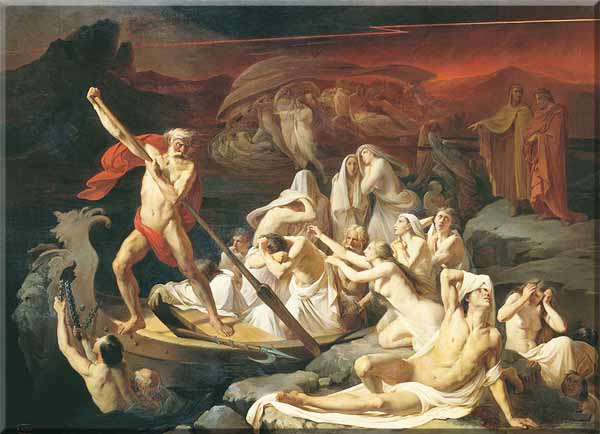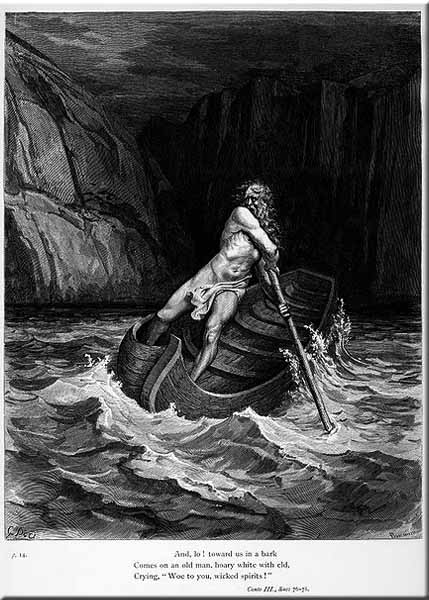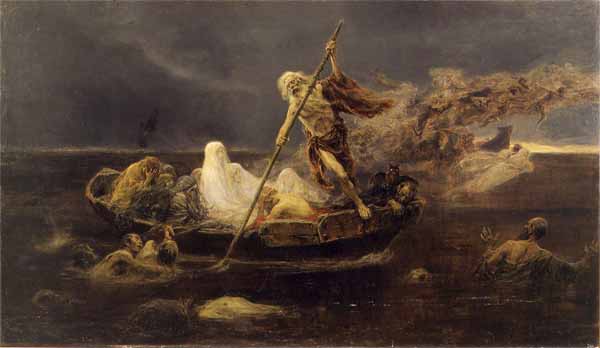Who the Hell was Charon?

Alexander Dmitrievich Litovchenko
1861
Russian Museum, St. Petersburg
From the Encyclopedia Brittanica:
Charon, in Greek mythology, the son of Erebus and Nyx (Night), whose duty it was to ferry over the Rivers Styx and Acheron those souls of the deceased who had received the rites of burial. In payment he received the coin that was placed in the mouth of the corpse. In art, where he was first depicted in an Attic vase dating from about 500 bc, Charon was represented as a morose and grisly old man. Charon appears in Aristophanes’ comedy Frogs (406 bc); Virgil portrayed him in Aeneid, Book VI (1st century bc); and he is a common character in the dialogues of Lucian (2nd century ad). In Etruscan mythology he was known as Charun and appeared as a death demon, armed with a hammer. Eventually he came to be regarded as the image of death and of the world below. As such he survives in Charos, or Charontas, the angel of death in modern Greek folklore.

And lo! towards us coming in a boat
An old man, hoary with the hair of eld,
Crying: ‘Woe unto you, ye souls depraved!’
From Wikipedia:
Greek mythology, Charon or Kharon (English pronunciation: /ˈkɛərɒn/, /ˈkɛərən/; Greek Χάρων) is the ferryman of Hades who carries souls of the newly deceased across the rivers Styx and Acheron that divided the world of the living from the world of the dead. A coin to pay Charon for passage, usually an obolus or danake, was sometimes placed in or on the mouth of a dead person.[1] Some authors say that those who could not pay the fee, or those whose bodies were left unburied, had to wander the shores for one hundred years. In the catabasis mytheme, heroes — such as Heracles, Orpheus, Aeneas, Dionysus and Psyche — journey to the underworld and return, still alive, conveyed by the boat of Charon.
The name Charon is most often explained as a proper noun from χάρων (charon), a poetic form of χαρωπός (charopós), “of keen gaze”, referring either to fierce, flashing, or feverish eyes, or to eyes of a bluish-gray color. The word may be a euphemism for death. Flashing eyes may indicate the anger or irascibility of Charon as he is often characterized in literature, but the etymology is not certain. The ancient historian Diodorus Siculus thought that the ferryman and his name had been imported from Egypt.
Charon is depicted frequently in the art of ancient Greece. Attic funerary vases of the 5th and 4th centuries BC. are often decorated with scenes of the dead boarding Charon’s boat. On the earlier such vases, he looks like a rough, unkempt Athenian seaman dressed in reddish-brown, holding his ferryman’s pole in his right hand and using his left hand to receive the deceased. Hermes sometimes stands by in his role as psychopomp. On later vases, Charon is given a more “kindly and refined” demeanor.
In the 1st century BC., the Roman poet Virgil describes Charon in the course of Aeneas’s descent to the underworld (Aeneid, Book 6), after the Cumaean Sibyl has directed the hero to the golden bough that will allow him to return to the world of the living:
There Chairon stands, who rules the dreary coast –
A sordid god: down from his hairy chin
A length of beard descends, uncombed, unclean;
His eyes, like hollow furnaces on fire;
A girdle, foul with grease, binds his obscene attire.
Other Latin authors also describe Charon, among them Seneca in his tragedy Hercules Furens, where Charon is described in verses 762-777 as an old man clad in foul garb, with haggard cheeks and an unkempt beard, a fierce ferryman who guides his craft with a long pole. When the boatman tells Hercules to halt, the Greek hero uses his strength to gain passage, overpowering Charon with the boatman’s own pole.
In the second century, Lucian employed Charon as a figure in his Dialogues of the Dead, most notably in Parts 4 and 10 (“Hermes and Charon” and “Charon and Hermes”).
In the 14th century, Dante Alighieri described Charon in his Divine Comedy, drawing from Virgil’s depiction in Aeneid 6. Charon is the first named mythological character Dante meets in the underworld, in the third canto of Inferno. Elsewhere, Charon appears as a cranky, skinny old man or as a winged demon wielding a double hammer, although Michelangelo’s interpretation, influenced by Dante’s depiction in Inferno, canto 3, shows him with an oar over his shoulder, ready to beat those who delay (“batte col remo qualunque s’adagia”, Inferno 3, verse 111).[8] In modern times, he is commonly depicted as a living skeleton in a cowl, much like the Grim Reaper or Dickens’ Ghost of Christmas Yet to Come

La Barca de Caronte
(The Barque of Charon)
Jose Benlliure y Gil
1919
